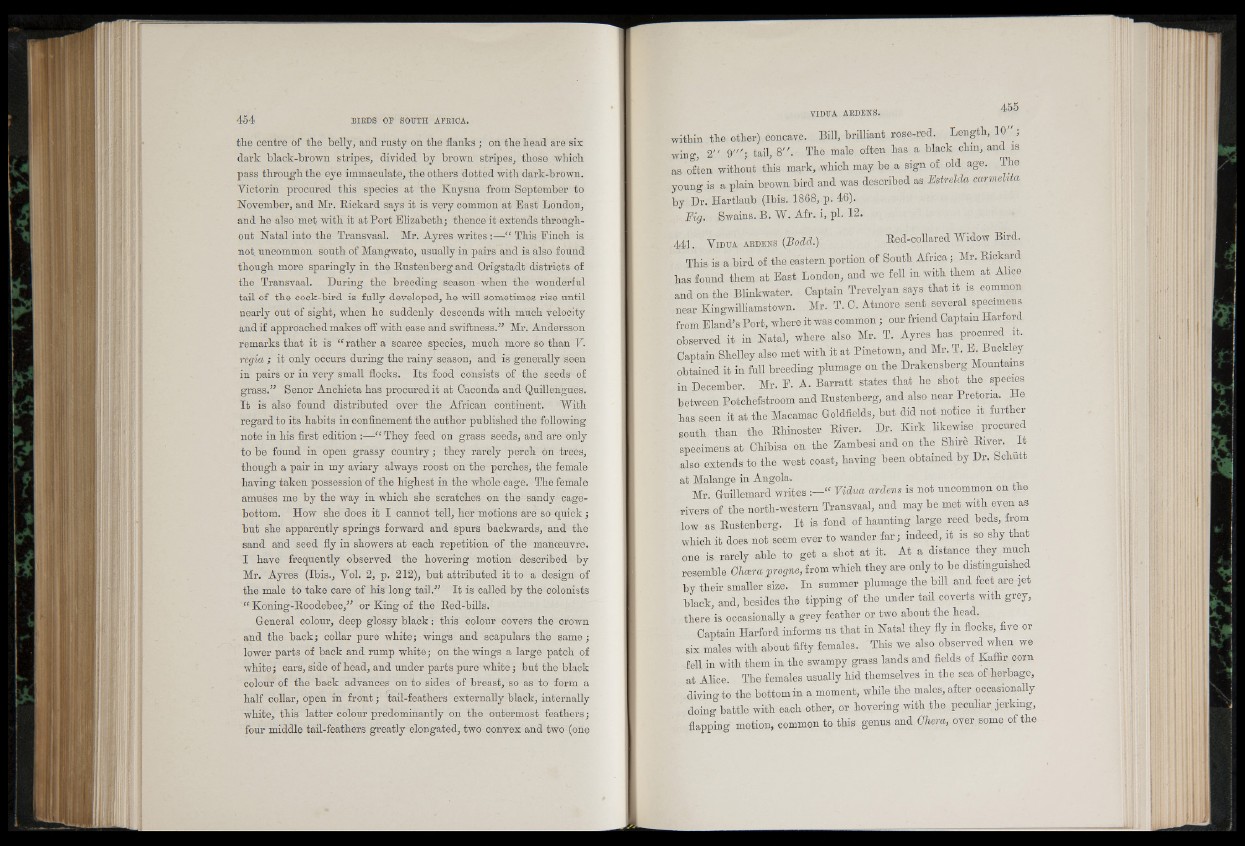
the centre of the belly, and rusty on the flanks; on the head are six
dai'k black-brown stripes, divided by brown stripes, those which
pass through the eye immaculate, the others dotted with dark-brown.
Victorin procured this species at the Knysna from September to
November, and Mr. Rickard says it is very common at East London,
and he also met with it at Port Elizabeth; thence it extends throughout
Natal into the Transvaal. Mr. Ayres writes :—“ This Einch is
not. uncommon south of Mangwato, usually in pairs and is also found
though more sparingly in the Rustenberg and Origstadt districts of
the Transvaal. During the breeding season when the wonderful
tail of the cock-bird is fully developed, he will sometimes rise until
nearly out of sight, when he suddenly descends with much velocity
and if approached makes off with ease and swiftness.” Mr. Andersson
remarks that it is “ rather a scarce species, much more so than V.
regia ; it only occurs during the rainy season, and is generally seen
in pairs or in very small flocks. Its food consists of the seeds of
grass.” Senor Anchieta has procured it at Caconda and Quillengues.
I t is also found distributed over the African continent. With
regard to its habits in confinement the author published the following
note in his first edition :—“ They feed on grass seeds, and are only
to be found in open grassy country; they rarely perch on trees,
though a pair in my aviary always roost on the perches, the female
having taken possession of the highest in the whole cage. The female
amuses me by the way in which she scratches on the sandy cage-
bottom. How she does it I cannot tell, her motions are so quick ;
but she apparently springs forward and spurs backwards, and the
sand and seed fly in showers at each repetition of the manoeuvre.
I have frequently observed the hovering motion described by
Mr. Ayres (Ibis., Vol. 2, p. 212), but attributed it to a design of
the male to take care of his long tail.” It is called by the colonists
“ Koning-Roodebec,” or King of the Red-bills.
General colour, deep glossy black: this colour covers the crown
and the back; collar pure white; wings and scapulars the same;
lower parts of back and rump white; on the wings a large patch of
white; ears, side of head, and under parts pure white; but the black
colour of the back advances on to sides of breast, so as to form a
half collar, open in front; tail-feathers externally black, internally
white, this latter colour predominantly on the outermost feathers;
four middle tail-feathers greatly elongated, two convex and two (one
akk
within the other) concave. Bill, brilliant rose-red. Length, 10 ,
wi-no* 2" Qy//* tail 8". The male often has a black chin, and is
n i »» i t r n i, as often without this mark, which may be a sign of old age. IDe
young is a plain brown bird and was described as Estrelda carmelita
by Dr. Hartlaub (Ibis. 1868, p. 46).
Fig. Swains. B. W. Afr. i, pi. 12.
441. V id u a a r d e n s {Bodd.) Red-collared Widow Bird.
This is a bird of the eastern portion of South Africa; Mr. Rickard
has found them at East London, and we fell in with them at Alice
and on the Blinkwater. Captain Trevelyan says that it is common
near Kingwilliamstown. Mr. T. C. Atrnore sent several specimens
from Eland’s Port, where it was common ; our friend Captain Harford
observed it in Natal, where also Mr. T. Ayres has procured it.
Captain Shelley also met with it at Pinetown, and Mr. T. E. Buckley
obtained it in full breeding plumage on the Drakensberg Mountains
in December. Mr. E. A. Barratt states that he shot the species
between Potchefstroom and Rustenberg, and also near Pretoria. He
has seen it at the Macamac Goldfields, but did not notice it further
south than the Rhinoster River. Dr. Kirk likewise procured
specimens at Chibisa on the Zambesi and on the Shire Rwer. lt
also extends to the west coast, having been obtained by Dr. Schutt
at Malange in Angola.
Mr Guillemard writes “ Vidua ardens is not uncommon on the
rivers of the north-western Transvaal, and may be met with even as
low as Rustenberg. It is fond of haunting large reed beds, from
which it does not seem ever to wander far; indeed, it is so shy that
one is rarely able to get a shot at it. At a distance they much
resemble OKcera progne, from which they are only to be distinguisned
by their smaller size. In summer plumage the bill and feet are jet
black, and, besides the tipping of the under tail coverts with grey,
there is occasionally a grey feather or two about the head.
Captain Harford informs us that in Natal they fly m flocks, five or
six males with about fifty females. This we also observed when we
fell in with them in the swampy grass lands and fields of Kaffir corn
at Alice. The females usually hid themselves in the sea of herbage,
diving to the bottom in a moment, while the males, after occasionally
doing battle with each other, or hovering with the peculiar jerking,
flapping motion, common to this genus and Chera, over some of the